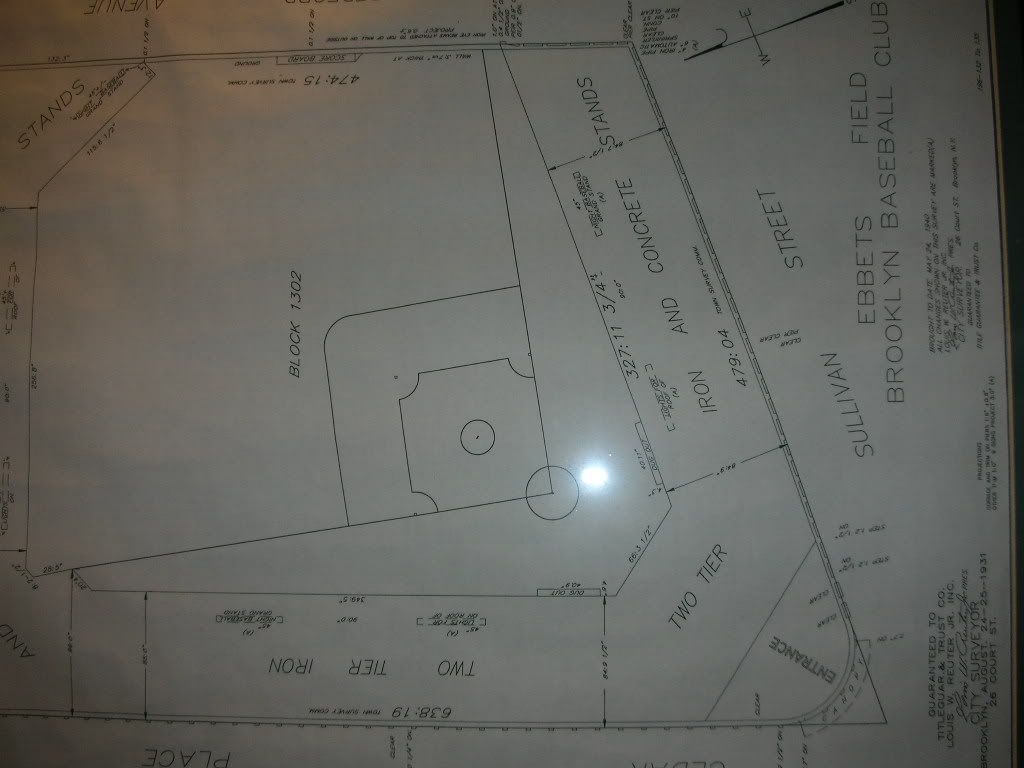Almost forgot, the one that's come in most handy,
A lufkin 1066D ruler is .05' wide or 5/8". Always used it in foundation work.
Ralph
11) Surveyors work in feet, tenths, and hundredths. The only people who work in inches are carpenters and... and... and...
I can't remember that other group.
> 11) Surveyors work in feet, tenths, and hundredths. The only people who work in inches are carpenters and... and... and...
>
> I can't remember that other group.
Hi Evan,
That's not entirely true, if you were to wander into NYC, you'll find that most of the highest priced properties in the World have been surveyed in feet and inches. It's part of what we call a City Survey.
Here's the original survey of Ebbets Field, note the Dimensions.

If you are like me, you probably need to recalibrate your waist height! For some reason my Levis keep getting lower and lower. 🙂 Jp
12) The only constant answer in surveying is “It depends”.
Miguel A. Escobar, LSLS, RPLS
Shhh...
I do still have 32x30s in the closet....trouble is, they're right next to the 36x30s that I wear.:-P
for me i can pace 2.5' per step and it's easy to count 5, 10, 15 and so on ( i am 5'10" or 5.83 )
also remember when in doubt whip the level out.
good thread! i have learned a couple of new tricks.
Shhh...
I like to consider myself vertically optimized and horizontally enhanced.
Concur with Ralph here.
All of Manhattan has been done in feet/inches/fractions....surveys often readoffsets and dimensions to 1/16". Same for Brooklyn.
Manhattan and Brooklyn tax maps were traditionally depicted in feet/inches, with a decimal point divider (thereby causing much consternation for surveyors from outside the city when trying to find out why 100.11 didn't quite fill the lot when they laid it off).
I've seen some surveys done in the other boroughs done feet/inches and then some in feet/tenths, although I believe feet/tenths is the preferred for the outer boroughs nowadays.
Only in the last five years did they change the tax map in all five boroughs to feet/tenths. But all those old deeds and filed maps are still in inches.
Also, knowing the "HI" of your eyes, nose and chin, for those awkward moments when you forgot to bring a ruler to get the HI of the instrument.
And the height of your knee, belt and shoulders for booting the rod......
Shhh...
Me....I'm just short for my weight.
Musta just been a midwest saying.
> Musta just been a midwest saying.
Or an architect thing. I have seen quite a few old deeds in ft/in, but not to many maps.. unless they were prepared by an architect in pre-CAD days
> The span of my hand, from thumb tip to pinkie tip is 8-in
Now this one I can relate to.
It's Scott with his 1/2" thumb nail: Mine's got a pretty good curve to it, where does his start and stop.
And Paden with his exact .10' knuckle, where's he starting and stopping that?
😉 :beer:
Cheers,
Dugger
I learned a couple too, it's those references to the horizon that'll throw you. If can't see the horizon, it doesn't do you any good.....
Radar
If pacing an approximate grid for a topo in open terrain: count 'double paces', ie only when the left (or right) foot hits the ground. A 20 yard grid only needs 10 double paces counted.
Knots to miles per hour: take the mph figure add a 1/10th, then half of that tenth.
eg 60 knots = 60+6+3 = 69 mph
"be nice to the eits - someday they may be your boss."
But why do they make it so damn hard to be nice?
Don
"People who espouse metrication should be institutionalized for their own safety...."
Now thats just crazy talk, SI is a superior system, thats why most of the world has adapted it...
Feet, inches, fractions of inch, perch, rod, pole, chain...bla bla. Metric is nice and simple, everything 10 based...
People always fear things they dont understand...lol (line from Batman Begins)
That's a very useful tip, I will have to try to use that in the field next time we work late, which now in the south the sun sets about 6pm +/-



